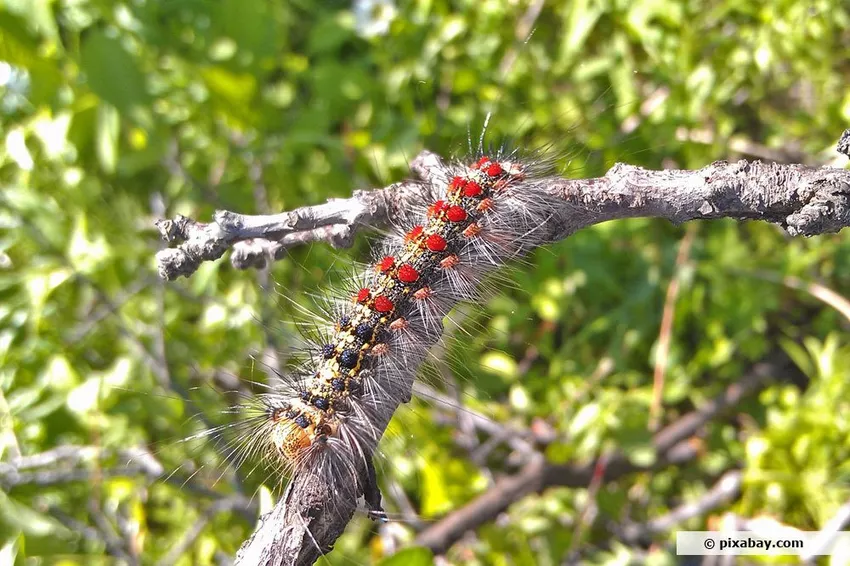
Bald forest areas and front gardens, black house facades - this is the work of the gypsy moth. The moth caterpillar is currently invading southern and eastern Germany in particular. And turns into a real nuisance. We clarify the most important questions: How dangerous is Lymantria dispar - the scientific name - for humans and nature? Is it maybe even poisonous? And above all: How do I get rid of him again?
The gypsy moth
The Research Institute for Forest, Snow and Landscape (WSL) speaks of a "major social problem" and in fact, for a few weeks now in Franconia, Thuringia and parts of northern Saxony there has been a picture that can well and happily also be taken from the Bible could have been taken. Like the locusts of old, millions of gypsy moth caterpillars are now attacking houses and gardens in the affected areas.
An infestation with the voracious pests is actually not a new phenomenon. Warm and dry early summers regularly cause the population to skyrocket. The extent that the whole thing is taking on this year is nevertheless extraordinary. And - coupled with the aggressiveness of the caterpillars - makes many garden and house owners despair. Because: There is no real aid in sight.
But first things first. First of all, we will provide you with some brief and concise information on how to identify the insect and its damage.
Recognize
- Moths from the owl moth family (Noctuidae)
- Slug moth (Lymantriinae)
- Females significantly larger than males
- Prefers to lay eggs on deciduous trees
- young caterpillars black with long hairs
- partial formation of stinging hairs
- red and blue colored warts on older specimens
- female caterpillars 6 to 8 cm long
- male caterpillars 4 to 5 cm
damage picture
- migrate to treetops after hatching
- Pitting in young leaves
- Eating whole leaves with age
- complete defoliation in case of mass infestation
- A particular focus is on fruit trees, oaks and hornbeams
- End of the feeding season with the beginning of the calendar summer
- Infested trees usually turn green again
- Exception: pre-damaged/weakened oaks
- Subsequent migration from forest plots to housing estates possible
- there during the day hidden from predators (on house walls and gutters)
- Eating under the cover of twilight
- not poisonous
- low allergy potential (reddening of sensitive areas on contact)
Fight gypsy moths
Unfortunately, there's not much they can do about it. Because the use of insecticides to control insects on a chemical basis is off the table in all affected municipalities, as of June 2022.
The reason: Possible damage to other living beings cannot be completely ruled out. The use of pesticides may harm the environment more than it actually benefits. "That would sweep away other insects across the board because it doesn't have a specific effect," says Konrad Nickschick, environmental service provider for the city of Gera.
The fact that the pest population often recovers more quickly from the use of chemical agents than their enemies also causes those responsible to hesitate. In addition, the larvae are already in the fourth larval instar, just before pupation. "We hope that it will be over in two to three weeks," Nickschick continued. For the coming year, however, a preventive use of a pesticide is being discussed in order to prevent mass proliferation at an early stage.
So those affected currently have little or no opportunity to get rid of the caterpillars of the gypsy moth. Fly screens have been distributed in some areas to prevent entry into houses and apartments. In addition, professional pest controllers are also on duty in many places to provide "first aid". Children or people with an increased allergy potential should also avoid direct skin contact with the stinging hairs of the caterpillar.
tip: In affected areas, be sure to keep all windows tightly closed, especially those on upper floors.
 Gypsy moth as moth
Gypsy moth as moth
Prevent
Furthermore, the WSL recommends the following measures for private gardeners to prevent future mass propagation:
- give as few opportunities for pupation as possible
- Mechanically destroying caterpillars, pupae, moths, clutches (e.g. rinsing with a water jet/high-pressure cleaner, collecting egg clutches)
- Catch the caterpillars in jute bags or with sticky traps
Encourage natural enemies
The best, because most natural solution to regulate the population of the gypsy moth in an ecological way is to use its predators. These include, among others:
- Great pupa robber (Calosoma sycophanta)
- Caterpillar flies (Tachinidae)
- Braconid wasps (Braconidae)
- Stink Bugs (Pentatomidae)
- Fur beetle (Dermestidae)
- Soldier beetles (Cantharidae)
- ants
- toads
- lizards
- Birds (tit, goldcrest, cuckoo)
- mice and shrews

sources
https://www.mdr.de/brisant/ratgeber/schwammspinner-invasion-was-tun-gegen-den-raupenbefall-100.html
https://www.spiegel.de/wissenschaft/natur/schwammspinner-raupenplage-in-gunzenhausen-und-gera-a-1272945.html
https://www.dora.lib4ri.ch/wsl/islandora/object/wsl:9120/datastream/PDF/view
